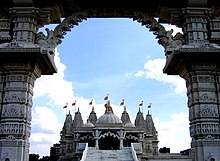Languages
The UK's de facto official language is English.[377][378] It is estimated that 95 per cent of the UK's population are monolingual English speakers.[379] 5.5 per cent of the population are estimated to speak languages brought to the UK as a result of relatively recent immigration.[379] South Asian languages, including Punjabi, Hindi, Bengali and Gujarati, are the largest grouping and are spoken by 2.7 per cent of the UK population.[379] According to the 2011 census, Polish has become the second-largest language spoken in England and has 546,000 speakers.[380] In 2019, some three quarters of a million people spoke little or no English.[381]
Three indigenous Celtic languages are spoken in the UK: Welsh, Irish and Scottish Gaelic. Cornish, which became extinct as a first language in the late 18th century, is subject to revival efforts and has a small group of second language speakers.[382] All four are recognised as regional or minority languages, by the European Union, under the European Charter for Regional or Minority Languages and the Framework Convention for the Protection of National Minorities.[383][2][384] As it is an EU member state, this therefore obliges the UK government to provide them specific measures of protection and promotion. In the 2001 Census over one-fifth (21 per cent) of the population of Wales said they could speak Welsh,[385] an increase from the 1991 Census (18 per cent).[386] In addition it is estimated that about 200,000 Welsh speakers live in England.[387] In the same census in Northern Ireland 167,487 people (10.4 per cent) stated that they had "some knowledge of Irish" (see Irish language in Northern Ireland), almost exclusively in the nationalist (mainly Catholic) population. Over 92,000 people in Scotland (just under 2 per cent of the population) had some Gaelic language ability, including 72 per cent of those living in the Outer Hebrides.[388] The number of schoolchildren being taught through Welsh, Scottish Gaelic and Irish is increasing.[389] Among emigrant-descended populations some Scottish Gaelic is still spoken in Canada (principally Nova Scotia and Cape Breton Island),[390] and Welsh in Patagonia, Argentina.[391]
Scots, a language descended from early northern Middle English, has limited recognition alongside its regional variant, Ulster Scots in Northern Ireland, without specific commitments to protection and promotion.[2][392]
It is compulsory for pupils to study a second language up to the age of 14 in England.[393] French and German are the two most commonly taught second languages in England and Scotland. All pupils in Wales are either taught Welsh as a second language up to age 16, or are taught in Welsh, as a first language.[394]
Religion
Forms of Christianity have dominated religious life in what is now the United Kingdom for over 1400 years.[395] Although a majority of citizens still identify with Christianity in many surveys, regular church attendance has fallen dramatically since the middle of the 20th century,[396] while immigration and demographic change have contributed to the growth of other faiths, most notably Islam.[397] This has led some commentators to variously describe the UK as a multi-faith,[398] secularised,[399] or post-Christian society.[400]
In the 2001 census 71.6 per cent of all respondents indicated that they were Christians, with the next largest faiths being Islam (2.8 per cent), Hinduism (1.0 per cent), Sikhism (0.6 per cent), Judaism (0.5 per cent), Buddhism (0.3 per cent) and all other religions (0.3 per cent).[401] 15 per cent of respondents stated that they had no religion, with a further 7 per cent not stating a religious preference.[402] A Tearfund survey in 2007 showed only one in ten Britons actually attend church weekly.[403] Between the 2001 and 2011 census there was a decrease in the number of people who identified as Christian by 12 per cent, whilst the percentage of those reporting no religious affiliation doubled. This contrasted with growth in the other main religious group categories, with the number of Muslims increasing by the most substantial margin to a total of about 5 per cent.[7] The Muslim population has increased from 1.6 million in 2001 to 2.7 million in 2011,[404] making it the second-largest religious group in the United Kingdom.[405]
In a 2016 survey conducted by BSA (British Social Attitudes) on religious affiliation; 53 per cent of respondents indicated 'no religion', while 41 per cent indicated they were Christians, followed by 6 per cent who affiliated with other religions (e.g. Islam, Hinduism, Judaism, etc.).[406] Among Christians, adherents to the Church of England constituted 15 per cent, Roman Catholic Church 9 per cent, and other Christians (including Presbyterians, Methodists, other Protestants, as well as Eastern Orthodox), 17 per cent.[406] 71 per cent of young people aged 18––24 said they had no religion.[406]
The Church of England is the established church in England.[407] It retains a representation in the UK Parliament and the British monarch is its Supreme Governor.[408] In Scotland, the Church of Scotland is recognised as the national church. It is not subject to state control, and the British monarch is an ordinary member, required to swear an oath to "maintain and preserve the Protestant Religion and Presbyterian Church Government" upon his or her accession.[409][410] The Church in Wales was disestablished in 1920 and, as the Church of Ireland was disestablished in 1870 before the partition of Ireland, there is no established church in Northern Ireland.[411] Although there are no UK-wide data in the 2001 census on adherence to individual Christian denominations, it has been estimated that 62 per cent of Christians are Anglican, 13.5 per cent Catholic, 6 per cent Presbyterian, and 3.4 per cent Methodist, with small numbers of other Protestant denominations such as Plymouth Brethren, and Orthodox churches.[412]



No comments:
Post a Comment